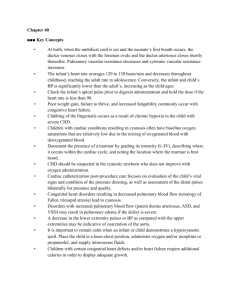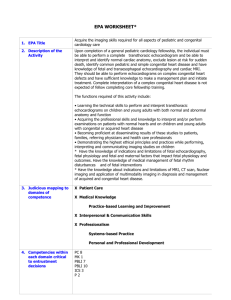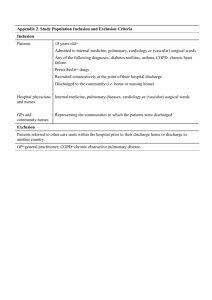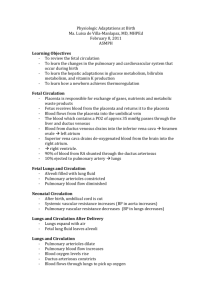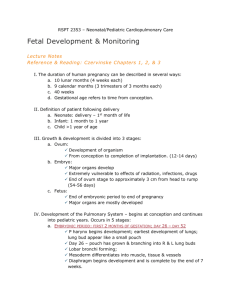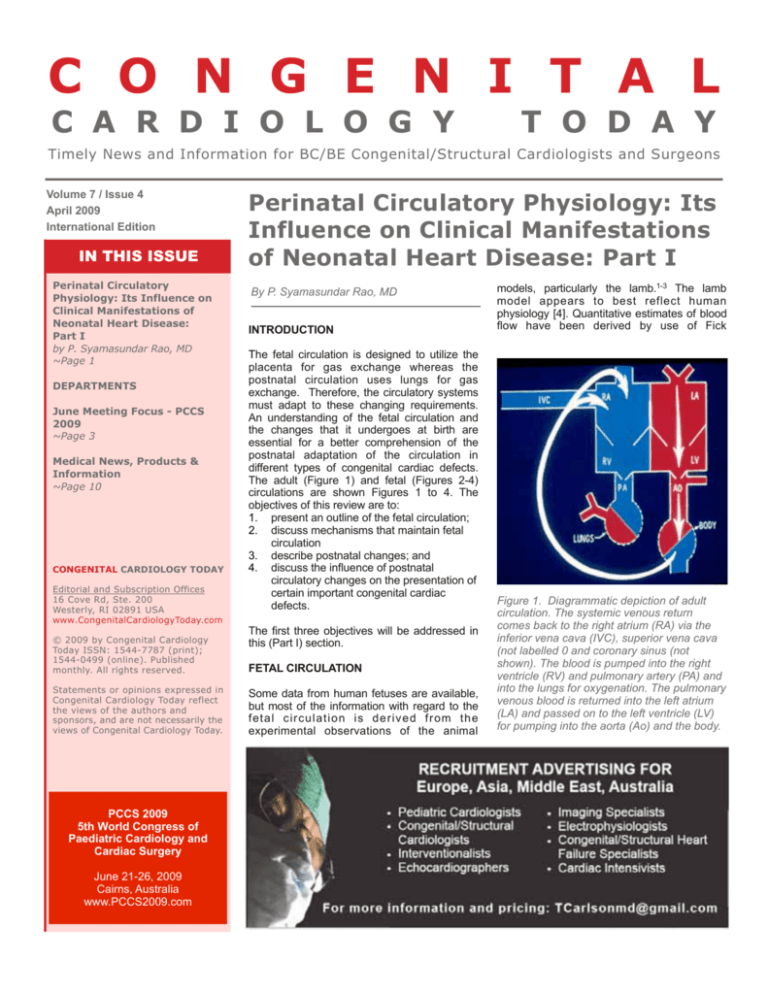
C O N G E N I T A L
C A R D I O L O G Y
T O D A Y
Timely News and Information for BC/BE Congenital/Structural Cardiologists and Surgeons
Volume 7 / Issue 4
April 2009
International Edition
IN THIS ISSUE
Perinatal Circulatory
Physiology: Its Influence on
Clinical Manifestations of
Neonatal Heart Disease:
Part I
by P. Syamasundar Rao, MD
~Page 1
DEPARTMENTS
June Meeting Focus - PCCS
2009
~Page 3
Medical News, Products &
Information
~Page 10
CONGENITAL CARDIOLOGY TODAY
Editorial and Subscription Offices
16 Cove Rd, Ste. 200
Westerly, RI 02891 USA
www.CongenitalCardiologyToday.com
© 2009 by Congenital Cardiology
Today ISSN: 1544-7787 (print);
1544-0499 (online). Published
monthly. All rights reserved.
Statements or opinions expressed in
Congenital Cardiology Today reflect
the views of the authors and
sponsors, and are not necessarily the
views of Congenital Cardiology Today.
PCCS 2009
5th World Congress of
Paediatric Cardiology and
Cardiac Surgery
June 21-26, 2009
Cairns, Australia
www.PCCS2009.com
Perinatal Circulatory Physiology: Its
Influence on Clinical Manifestations
of Neonatal Heart Disease: Part I
By P. Syamasundar Rao, MD
INTRODUCTION
The fetal circulation is designed to utilize the
placenta for gas exchange whereas the
postnatal circulation uses lungs for gas
exchange. Therefore, the circulatory systems
must adapt to these changing requirements.
An understanding of the fetal circulation and
the changes that it undergoes at birth are
essential for a better comprehension of the
postnatal adaptation of the circulation in
different types of congenital cardiac defects.
The adult (Figure 1) and fetal (Figures 2-4)
circulations are shown Figures 1 to 4. The
objectives of this review are to:
1. present an outline of the fetal circulation;
2. discuss mechanisms that maintain fetal
circulation
3. describe postnatal changes; and
4. discuss the influence of postnatal
circulatory changes on the presentation of
certain important congenital cardiac
defects.
The first three objectives will be addressed in
this (Part I) section.
FETAL CIRCULATION
Some data from human fetuses are available,
but most of the information with regard to the
fetal circulation is derived from the
experimental observations of the animal
models, particularly the lamb.1-3 The lamb
model appears to best reflect human
physiology [4]. Quantitative estimates of blood
flow have been derived by use of Fick
Figure 1. Diagrammatic depiction of adult
circulation. The systemic venous return
comes back to the right atrium (RA) via the
inferior vena cava (IVC), superior vena cava
(not labelled 0 and coronary sinus (not
shown). The blood is pumped into the right
ventricle (RV) and pulmonary artery (PA) and
into the lungs for oxygenation. The pulmonary
venous blood is returned into the left atrium
(LA) and passed on to the left ventricle (LV)
for pumping into the aorta (Ao) and the body.
April 2009
2
CONGENITAL CARDIOLOGY TODAY
Figure 2. Diagrammatic depiction of fetal circulatory pathways.
The placental venous return is carried by the umbilical vein,
passes through the ductus venosus and reaches the inferior vena
cava (not labeled) and right atrium (RA). From there a substantial
proportion is shunted into the left atrium (LA) via the foramen
ovale. The remaining portion goes into the right ventricle (RV).
LV, left ventricle.
principle, electromagnetic flow transducers and by radionuclidelabeled microspheres. In the fetal circulatory states the cardiac
output is expressed as the combined output of both ventricles in
contradistinction to the postnatal circulatory states where the
cardiac output is measured as the volume ejected by each ventricle.
Course of the Fetal Circulation
The oxygenated blood from the placenta is returned via the
umbilical vein; the later enters the inferior vena cava via the ductus
venosus (Figure 2). Nearly one-half of the umbilical venous blood
goes through the liver and reaches the inferior vena cava via the
hepatic veins. A substantial amount of the inferior vena caval blood
is preferentially shunted into the left atrium (Figure 2). This appears
to be related to the fact that the crista dividens, forming the upper
margin of the foramen ovale (free margin of the septum secundum)
“Fetal circulation is intended to utilize
placenta for gas exchange while
postnatal circulation uses lungs for gas
exchange.”
www.CongenitalCardiologyToday.com
CONGENITAL CARDIOLOGY TODAY
3
April 2009
JUNE MEETING FOCUS
5th World Congress of Paediatric Cardiology and
Cardiac Surgery
June 21-26, 2009
Cairns, Australia
www.pccs2009.com
All delegates will be registered for one of the specialty
meetings, which will provide a focused start to the World
Congress. The “Specialty Meetings” will comprise:
• Interventional (jointly organized with PICS) (3 days: Sun.,
Mon. and Tue.) “PICS at the World Congress”
• Surgical (jointly organized with WSPCHS) (Mon. and
Tue.) “Second Biennial Scientific Meeting of The World
Society for Pediatric and Congenital Heart Surgery at the
World Congress”
• Pediatric Cardiac Intensive Care (Mon. and Tue.) jointly
organized with PICS-AICS (includes perfusion and
anesthesia)
• Adult Congenital Heart Disease (Mon. and Tue.) jointly
organized with International Society for Adult Congenital
Heart Disease (ISACHD)
• Pediatric Electrophysiology / Arrhythmia (Mon. and Tue.)
jointly organized with PACES and PEDIRHYTHM
• Imaging (including Fetal Echocardiography / MRI and CT)
(Mon. and Tue.)
• Nursing (Mon. and Tue.)
• Pediatric Cardiomyopathy / Transplant (Mon.) Pulmonary
Hypertension (Tue.)
Thereafter, the meeting will be comprised of a series of
plenary meetings, each exploring a specific topic, alongside
free abstract sessions and educational activities for
trainees.
There will be Landmark Lectures on Friday - June, 26 2009
9:00 am–12:00 pm - by:
• Anatomy of Congenital Heart Disease
- Prof. Robert Anderson (London)
• Pediatric Cardiology
- Prof. Andrew Redington (Toronto)
• Pediatric Cardiac Surgery
- Prof. Pascale Vouhe (Paris)
• Pediatric Cardiac Nursing
- Ms. Kathy Mussato (Milwaukee)
• Pediatric Cardiac Intensive Care
- Prof. Gil Wernovsky (Philadelphia)
Be sure to attend the evening Gala Function, "Beyond the
Barrier Australian Experience," on Thursday, June 25th.
Figure 3. Diagrammatic depiction of fetal circulatory pathways.
The blood reaching the left atrium (LA) via the foramen ovale is
passed on to the left ventricle (LV) and from there into the aorta.
The oxygenated blood reaches the coronary arteries (not shown)
and central nervous system via the brachio-cephalic (BRACH.)
vessels. PA, pulmonary artery; RA, right atrium, RV, right ventricle.
overrides the inferior vena cava (Figure 5).5 The free edge of the
lower margin of the foramen ovale, formed by the septum primum,
is on the left side of atrial septum and the foramen ovale is kept
open by the inferior vena caval stream (Figures 2 and 5). In
addition, the inferior vena caval valve (Eustachian valve) diverts the
inferior vena caval blood stream towards the atrial septum.6
Consequently, the oxygenated blood enters the left ventricle and
then the ascending aorta (Figure 3). Therefore, the brain (via the
brachio-cephalic vessels) and the heart (via the coronary arteries)
are perfused with oxygenated blood (Figure 3). The pulmonary
venous return does mix with the left atrial blood but, because of
small amount of return (7% of combined ventricular output), it does
not significantly desaturate the highly saturated umbilical venous
return. The coronary venous and superior vena caval blood along
with the portion of the inferior vena caval blood that did not stream
into the left atrium, enter the right ventricle via the tricuspid valve
(Figure 3). This desaturated blood is pumped by the right ventricle
into the main pulmonary artery (Figure 4). From the main pulmonary
artery, a small amount of right ventricular ejectate enters the lungs
and the majority is pumped into the descending aorta via the ductus
arteriosus. Thus, the desaturated blood makes its way into the
placenta for oxygenation via the umbilical arteries (Figure 4).
Mechanisms Maintaining Fetal Circulatory Pathways
The ductus venosus and umbilical vessels are kept open by the
mechanical effect of flow through them.
www.CongenitalCardiologyToday.com
April 2009
4
Figure 4. Diagrammatic depiction of fetal circulatory pathways.
The right ventricular (RV) blood is pumped into the pulmonary
artery (not labeled) and because of high resistance pulmonary
circuit the majority of the blood is shunted via the ductus
arteriosus into the descending aorta. From there the desaturated
blood is returned to placenta via the umbilical arteries. LA, left
atrium; LV, left ventricle; RA, right atrium.
The foramen ovale is kept patent in the fetus because of the
mechanical effect of streaming of the inferior vena caval blood into
the left atrium (Figures 2 and 5) and the physical relationship of the
inferior vena cava to the left atrium (Figures 5).
Because of the muscular nature of the ductus arteriosus, it may
have to be kept open by active dilatation. Studies examining this
issue suggest that both the locally produced and circulating
prostaglandins (E2 and possibly I2) may be responsible for this.
Prostaglandins are rapidly cleared by passage through the lungs.
Since the pulmonary blood flow is very low in the fetus (7% of
combined ventricular output) circulating prostaglandins are high in
the fetus in contradistinction to postnatal life when the
prostaglandins are rapidly cleared by passage through the lungs.
In addition, the placenta produces large quantities of
prostaglandins. The patency of the ductal may also be related to
circulating adenosine 7.
Since the ductus arteriosus is large, the pressures in the main
pulmonary artery and descending aorta are equal. Consequently,
the quantity of blood flow going into the placenta vs. lungs depends
upon their relative resistances. Since the placental circulation is a
low resistance circuit, a larger proportion of the blood goes into the
placenta. Because the pulmonary circulation is a high resistance
circuit, a smaller proportion of the combined ventricular output
makes it way into the lungs. The causes of this high pulmonary
CONGENITAL CARDIOLOGY TODAY
Figure 5. Diagrammatic depiction of fetal circulatory pathways
(left) showing the passage of inferior vena caval blood into the
left atrium (LA) via the foramen ovale. When examining the
inferior portion of the heart from the inferior vena cava (right),
note that a greater portion of the left atrium is seen, explaining in
part the reason for shunting the inferior vena caval blood into
the LA. CHRISTA, Christa dividens; LV, left ventricle.
vascular resistance are not clearly understood. Kinking and high
degree of tortuosity of the small pulmonary vessels have been
suggested as causes,8 but there is no general agreement of this
causative relationship. Some studies 9,10 demonstrated that the
pulmonary arterioles have a thick smooth muscle layer which may
be responsible for the high resistance. Low partial pressure of
oxygen (to which the pulmonary arterioles are subjected to) keeps
them thick and constricted. The pulmonary vascular resistance
may also be influenced by changes in the pH and PCO2 as well as
autonomic nervous system.9,10 Many endogenous and exogenous
vaso-active materials also stimulate the fetal pulmonary
vasculature. Several studies demonstrate that pharmacologic
doses of prostaglandins have dramatic effect on the fetal
pulmonary circulation.9,11 Prostaglandin F2 and leukotrienes
(LTD 4 ) produce pulmonary vasoconstriction whereas
prostaglandins E1, E2 and I2 produce pulmonary vasodilatation.12
The role of prostaglandins in maintaining a normally high
pulmonary vascular resistance however, is not clearly defined. It is
possible that prostaglandins mediate the hypoxic stimulus.
Distribution of the Cardiac Output and Oxygen Saturations in
the Fetus
As mentioned in the preceding section, cardiac output is expressed
as combined output (CVO) of both ventricles. The CVO in the lamb
www.CongenitalCardiologyToday.com
CONGENITAL CARDIOLOGY TODAY
5
April 2009
Figure 7. Diagrammatic depiction of changes in fetal circulation
at birth. These include removal of placenta, constriction of ductus
venosus, closure of foramen ovale and constriction of ductus
arteriosus.
MYOCARDIAL FUNCTION IN THE FETUS
Figure 6. Diagrammatic depiction of fetal circulatory pathways
illustrating the percent combined ventricular output for each
cardiac/vascular chamber. The numbers indicate percent of
combined ventricular output. Ao, aorta; BCAs, brachiocephalic
arteries; CAs, coronary arteries; CS, Coronary sinus; DA ductus
arteriosus; DV, ductus venosus; HV, hepatic vein; IVC, inferior
vena cava; LA, left atrium; Liv, liver; LV, left ventricle; PA,
pulmonary artery; Pla, placenta; PVs, pulmonary veins; RA, right
atrium, RV, right ventricle; SVC, superior vena cava; UAs,
umbilical arteries; UV, umbilical vein.
is 200 ml/kg/minute.4 The estimates of relative distribution of the
CVO based on the data derived from chronically instrumented
lambs13,14 are shown in Figure 6. Oxygen saturations and PO2s are
lower in the fetus than those in the neonates, infants and children.14
This may be related to lower efficiency of the placenta to transport
oxygen than the lungs. However, the fetus adapts to these lower
levels by virtue of higher fetal hemoglobin levels; the fetal
hemoglobin has low P50 of 18 to 19 torr which facilitates greater
oxygen uptake from the placenta. Furthermore, the distribution of
the blood to the various organs and the placenta is most
advantageous in that the highly saturated blood goes to the heart
and brain and low saturated blood to placenta.
The fetal myocardial structure differs significantly from that of the
adult. In the adult the myocardial cells are compact with small
nuclei and with little or no connective tissue surrounding them. In
contradistinction, the fetal myocardial cells are less well organized,
have large nuclei (sometimes even multinucleated), and the
number of sarcomeres per unit is less. Also, the organization and
function of the sarcoplasmic reticulum is incomplete which
increases progressively with increasing fetal age. A similar pattern
is seen with the development of t-tubule system.15 The amount of
areolar tissue in between the fetal myocardial cells is large [16]. It
also appears that the sympathetic innervation of the heart is not
completely developed in the fetus.14,16 There are also differences in
the type of substrates utilized, type of contractile protein activated,
production and delivery of high energy phosphate, method of
calcium delivery, and response of contractible elements to calcium
ions between fetal, neonatal and adult myocardium .15
The described structural and functional differences result in
physiologic effects, namely, greater resting tension at a given
muscle length and a lesser tension developed at any resting length
in the fetus than in the adult. 16 While the initial studies suggested
that the fetal cardiac output is mostly regulated by a change in the
heart rate rather than by a change in the stroke volume,
subsequent studies indicated that the Frank-Starling mechanism is
indeed operative in the fetus, but within the narrow physiologic
range.17 Increase in the afterload adversely affects the fetal heart.18
www.CongenitalCardiologyToday.com
April 2009
6
CONGENITAL CARDIOLOGY TODAY
POSTNATAL CIRCULATORY CHANGES
The circulatory changes at birth are elimination of the placenta
(Figure 7), maturation of the pulmonary circulation, and closure of
fetal circulatory pathways (Figure 7). There is an impressive
immediate change at birth followed by a slow change until an adult
type of cardiovascular system is achieved; this may occur over
varying time periods.
! "#$%&'
(")! *+),% -./ 0
Elimination of the Placenta
At birth, the placenta is removed as a matter of normal birth
process and the lungs must assume the gas exchange function
acutely. Elimination of placental circulation causes elevation of the
systemic vascular resistance because of exclusion of low
resistance placental circuit.
Development of Pulmonary Circulation
Soon after the delivery respiration begins and within a few minutes
after birth almost complete expansion of the lungs occurs. There is
striking decrease in the pulmonary vascular resistance and a distinct
increase in the pulmonary blood flow at birth. This is associated with
a fall in pulmonary arterial pressures. Expression of the fluid from
the alveoli and expansion of the lungs are responsible to a great
degree for the fall in the pulmonary vascular resistance.9,19,20 Other
factors that may affect a decrease in the pulmonary resistance are
decreased PCO2, increase in pH and increase in alveolar and blood
PO2. The consensus of opinion is that an increase in PO2 in the
alveoli and blood is the most potent and important pulmonary
vasodilator at birth. The alveolar gaseous oxygen diffuses in
sufficient quantities into the region of precapillary vessels making
themdilate. The mechanism by which the oxygen induces
pulmonary arteriolar dilation is not understood. It may directly affect
the pulmonary arteriolar smooth muscle cells or its action is
mediated through a chemical substance. The oxygen may activate
kininogen to bradykinin. Bradykinin is a potent pulmonary
vasodilator. The effect of bradykinin itself may be mediated through
prostocyclin. A rapid increase in bradykinin levels in the left atrium
after ventilation with oxygen supports bradykinin mediated action of
oxygen. Since the increased bradykinin levels last for a short period
of time one may question the validity of bradykinin mediation as the
sole factor responsible for pulmonary vascodilation. Pulmonary
vasodilatation induced by oxygen occurs in two phases. The initial
rapid phase cannot be inhibited by indomethacin and therefore is
not dependent upon prostocyclin-mediation. The subsequent slow
phase of the oxygen-medicated pulmonary vasodilatation may be
influenced by prostaglandins.21 Decrease in pulmonary vascular
resistance increases the pulmonary blood flow markedly.
Further decrease in the pulmonary vascular resistance and
involution of the pulmonary arteriolar medial musculature take
place more gradually. The pulmonary vasculature looks very
similar to that of the adult by the age of 6 to 8 weeks. Pulmonary
parenchymal disease states causing alveolar hypoxia and
reduced inspired oxygen such as in high altitude may prevent
www.CongenitalCardiologyToday.com
CONGENITAL CARDIOLOGY TODAY
normal maturation/involution of pulmonary vasculature. Elevated
pulmonary artery pressure associated with congenital heart defects
(for example large ventricular septal defect or patent ductus
arteriosus) may also retard the normal involution of the pulmonary
arterioles.
Closure of the Fetal Circulatory Pathways
Patent foramen ovale. As alluded to in the preceding section,
decrease in the pulmonary arteriolar resistance is associated with an
increase in the pulmonary flow which in turn increases the volume of
blood flow return to the left atrium with consequent increase in the
left atrial pressure. Shortly before this, the placenta is eliminated with
consequent decrease in the umbilical venous and inferior vena caval
flow. This will result in a slight decrease in the right atrial pressure. A
combination of increase in the left atrial pressure and decrease in the
right atrial pressure will result in apposition of the septum primum
and septum secundum causing in functional closure of foramen
ovale. This occurs within the first few hours after birth. The functional
closure of the foramen ovale is often incomplete, especially if there is
an increase in the right atrial pressure (e.g., crying, pulmonary
vasoconstriction, severe right atrial or ventricular obstruction), and/or
a decrease in the left atrial pressure, with resultant right-to-left
interatrial shunting. Severe dilatation of the left atrium secondary to
increased pulmonary blood flow (for example patent ductus
arteriosus or ventricular septal defect) may stretch the patent
foramen ovale, causing left-to-right shunting.
While functional closure of the foramen ovale occurs within hours
after birth, anatomic closure may take 2 to 3 months [22,23]. In
some subjects, the closure does not take place at all. Several
studies have shown persistent patency in nearly 20% of older
infants, children, adolescents, and adults.24
7
the smooth muscle cells of the ductal tissue is responsible for
ductal closure. The ductal constriction may also be mediated
through cyctocrome and thromboxane systems. Several studies
suggest a definitive role of prostaglandins in either initiating ductal
constriction or mediating ductal constrictive effect of oxygen.30
Relaxation property of ductal muscle with prostaglandins seems to
develop early in fetal life. The prostaglandin mediated ductal
relaxing mechanism is most active at about 0.7 gestation. With
increasing gestational age the ductal muscle becomes less
responsive to prostaglandins while it acquires increasing
sensitivity to oxygen. It would appear that prostaglandins
indirectly contribute to ductal closure by becoming less effective
after birth and potentiate constrictive action of oxygen.
SUMMARY AND CONCLUSIONS
Fetal circulation is intended to utilize placenta for gas exchange while
postnatal circulation uses lungs for gas exchange. Fetal circulatory
pathways, namely, umbilical vessels, ductus venosus, foramen
ovale and ductus arteriosus, high pulmonary vascular resistance
and low placenta resistance facilitate placental gas exchange and
promote distribution of oxygenated blood to the vital organs of the
fetus. Mechanical factors, prostaglandins and low PO2 in the lung
keep the fetal circulatory pathways open. Postnatal circulatory
changes are elimination of the placenta, development of pulmonary
circulation, and closure of fetal circulatory pathways. The influence
of postnatal circulatory changes on the clinical presentation and
clinical course of the neonate with congenital heart defects will be
dealt with in Part II of this review to be published in the next issue
of Congenital Cardiology Today.
REFERENCES
1.
Ductus venosus. The ductus venosus also closes shortly after
birth. The closure may simply be due to lack of blood flow through
this structure following elimination of placenta. Or, the mechanism
of closure may be similar to that of ductus arteriosus.
2.
3.
Ductus arteriosus. Two stages of ductus arteriosus closure
following birth have been described, the first, functional closure by
constriction of ductal muscle occurs within 10 to 15 hours of age.
3,19,22,25 The second, anatomic closure occurs by endothelial
destruction, subintimal layer proliferation, connective tissue
formation over the next two to three weeks. Increase in oxygen
tension produces muscular constriction of ductal muscle, causing
the ductus to close.26,27 In contradistinction, situations with low
oxygen such as high altitudes or when the neonate is exposed to
low oxygen concentrations, the ductal closure is delayed.28,29
Vasoactive substances such as histamine, 5-hydroxytryptamine,
acetylcholine, bradykinin and catecholamine may have a role in
ductal closure although their role has not been fully delineated.
4.
5.
6.
7.
8.
The mechanism of action of O2 in ductal closure is not clearly
elucidated, but most authorities suggest that direct stimulation of
April 2009
Rudolph AM, Heymann MA. The circulation of the fetus in
utero: Methods for studying distribution of blood flow, cardiac
output and organ blood flow. Circ Res 1967; 21: 163.
Rudolph AM, Heymann MA. Circulatory changes during growth
in the fetal lamb. Circ Res 1970; 26: 289.
Rudolph AM. Fetal and neonatal pulmonary circulation. Ann
Rev Physiol 1979; 41: 383.
Rudolph AM. The changes in circulation at birth: Their
importance in congenital heart disease. Circulation 1970; 41:
343-59.
Barclay AE, Franklin KJ, Prichard MML. The foetal circulation
and cardiovascular system and the change that they undergo at
birth. Oxford, Blackwell Scientific, 1944.
Ho SY, Angelini A, Moscoso G.
Developmental cardiac
anatomy. In: Long WA (Ed), Fetal and Neonatal Cardiology.
Philadelphia, WB Saunders Co., 1990, pp. 3-16.
Mentzer RM, Ely SW, Lasley RD, et al. Hormonal role of
adenosine in maintaining patency of the ductus arteriosus in the
fetal lambs. Ann Surg 1985; 202: 223-30.
Reynolds SRM. Fetal and neonatal pulmonary vasculature in
guinea pig in relation to hemodynamic changes at birth. Amer J
Anat 1956; 98: 97-102.
www.CongenitalCardiologyToday.com
November 2007
April 2009
9.
10.
11.
12.
13.
14.
15.
16.
17.
18.
!!!!!!!!!!!!!!!!!
19.
20.
!!!!!!!!!!!!!!!!!
8
Cassin S, Dawes GS, Mott JC, et al.
The vascular resistance of the fetal
newly ventilated lung of the lamb. J
Physiol (London) 1964; 171: 61-79.
Cook CD, Drinker PA, Jacobsen HN, et
al. Control of pulmonary blood flow in
the fetal and newly born lamb. J Physiol
(London) 1963; 169: 10-29.
Kadowitz PJ, Joiner PD, Hyman AIL,
George WJ. Influence of PGE1 and
F2α on pulmonary vascular resistance,
isolated lobar vessels, and cyclic
nucleotide levels. J Pharmacol Exp
Ther 1975; 192: 677-87.
Cassin S, Tyler T, Leffler C, Wallis R.
Role of prostaglandins in control of fetal
and neonatal pulmonary circulation. In:
Lango L, Reneau DD (Eds), Fetal and
Newborn Cardiovascular Physiology,
New York, Garland STPM Press, 1978,
pp. 439-64.
Heymann MA, Creasy RR, Rudolph
AM. Quantitation of blood flow patterns
in the foetal lamb in utero. In Foetal
and Neonatal Physiology. Proceedings
of Sir Joseph Barcroft Centenary
Symposium, Cambridge, Cambridge
Univ. Press, 1973, p. 89, p. 129.
Rudolph AM. Congenital Diseases of
the Heart. Chicago, Year Book Medical
Publishers, Inc., 1974, pp. 1-41.
Gingell RL. Developmental biology of
mammalian myocardium. In: Freedom
RM, Benson LN, Smallhorn JF (Eds):
Neonatal Heart Disease. London,
Springer-Verlag, 1992, pp. 35-44.
Friedman WF. The intrinsic physiologic
properties of the developing heart.
Prog Cardiovasc Dis 1972; 15: 87-111.
Kirkpatrick SE, Pitlick PT, Naliboff J,
F r i e d m a n W F. F r a n k - S t a r l i n g
relationship as an important
determinant of fetal cardiac output.
Amer J Physiol 1976; 231: 495-500.
Gilbert RD. Effect of afterload and
barorecptors on the cardiac function in
fetal sheep. J Dev Physiol 1982; 4:
!!!!!!!!!!!!!!!!!
299-309.
Dawes GS. Foetal and neonatal
physiology. Chicago, Year Book
Medical, 1968.
Teitel DF, Iwamoto HS, Rudolph AM.
Effect of birth related events on the
central flow patterns. Pediat Res 1987;
22: 557-66.
CONGENITAL CARDIOLOGY TODAY
21. Leffler CW, Hassler JR, Terrango NA.
Ve n t i l a t i o n - i n d u c e d r e l e a s e o f
prostaglandin-like material from fetal
lungs. Am J Physiol 1980; 238: H282-6.
22. Christie A. Normal closing time of the
foramen ovale and the ductus
arteriosus: an anatomic and statistical
study. Am J Dis Child 1930; 40: 323-6.
23. R a o P S . P e r i n a t a l c i r c u l a t o r y
physiology. Indian J Pediat 1991;
58:441-51.
24. Rao PS. The femoral route for cardiac
catheterization of infants and children.
Chest 1973; 63: 239-41.
25. Moss AJ, Emmanouilides GC, Duffie
ER, Jr. Closure of ductus arteriosus.
Lancet 1963; 1: 703-4.
26. Kennedy JA, Clark SL. Observations
on the physiologic reactions of the
ductus arteriosus. Am J Physiol 1942;
136: 140-7.
27. Heymann MA, and Rudolph AM.
Control of ductus arteriosus. Physiol
Rev 1975; 55: 62-78.
28. Moss AJ, Emmanouilides GC, Adams
FA, Chuang K. Response of ductus
arteriosus and pulmonary and systemic
arterial pressure to changes in oxygen
environment in newborn infants.
Pediatrics 1964; 33: 937-44.
29. Penaloza D, Arias-Stella J, Sime F, et
al. The heart and pulmonary circulation
in children at high altitudes. Pediat
1964; 34: 568-82.
30. C o c e a n i F a n d O l l e y P M .
Prostaglandins and the ductus
arteriosus. Pediat Cardiol 1983; 4
(Suppl II): 33-7.
CCT
P. Syamasundar Rao, MD
Professor and Division Director,
Department of Pediatric Cardiology
Division of Pulmonary and Critical
Care Medicine
University of Texas - Houston Medical
School
6431 Fannin St., MSB 3.132
Houston, TX 77030 USA
Phone: 713-500-5738
Fax: 713-500-0653
P.Syamasundar.Rao@uth.tmc.edu
Do you or your colleagues
have interesting research
results, observations,
human interest stories,
reports of meetings, etc.
that you would like
to share with the
congenital cardiology
community?
Submit a brief summary of your
proposed article to:
RichardK@CCT.bz
The final manuscript may be
between 400-4,000 words,
contain pictures, graphs,
charts and tables.
!
!
!!!!"#$!%&'(#!)*+,'-.$!/-0+,&(1-+!!
!!!!!!!!!!!!!!!!!
!"#"$%&'$()*+$!,--.+$/0$121*3$$$$$$$$$$$$$$$$$$$$$$$$$$$$$$$$$$$$$$$$$$$$$$$$$$$$
4,56$378"221"9923$$$$$$$:;<&=>?-@AB.;C-&D,"&-E$$$$$$$FFF">?-@AB.;C-&D,"&-E$$$$$$$$$$$$$$$$$$
!!!!"#$!%&'(#!)*+,'-.$
!!!!!!!!!!!!!!!!!!!!!!!!!
)*.2(-.34!G?-C:&D.&H?@A.+$I,J@-&H,;:?+$KJBL5,$M,?N;,BB+$O',-L:B,$P;@&5,-?;L,+$$$$$$$$$$$$$$
Q-&F@A$R,@?-C?@:&;!
!"#"$%&'$()*+$!,--.+$/0$1
4,56$378"221"9923$$$$$$$:;<&=>?-@AB.;C-&D,"&-E
!!!!!!!!!!!!!!!!!!!!
!!!!!!!!!!!!!!!!!
!
!!!!!!!!!!!!!!!!!!!!!!!!!
www.CongenitalCardiologyToday.com
)*.2(-.34!G?-C:&D.&H?@A.+$I,J@-&H,;:?+$KJBL5,$M
Q-&F@A$R,@?-C?@:&;!
April 2009
10
CONGENITAL CARDIOLOGY TODAY
Medical News, Products & Information
UC San Diego Engineer Develops Method to Combat
Congenital Heart Disease in Children
Congenital heart defects account for five times more deaths
annually than all childhood cancers combined. Alison Marsden,
an Assistant Mechanical and Aerospace Engineering Professor
at the University of California at San Diego, has developed a
unique set of computer modeling tools that are expected to
enhance pediatric surgeons' ability to perform heart surgery on
children. Marsden's work focuses on designing and using
simulation tools to provide a way of testing new surgery
designs on the computer before trying them on patients, much
like, for example, engineers use computer codes to test new
designs for airplanes or automobiles.
Marsden has come up with a way to optimize a Y-Graft model
for the Fontan procedure which can help pediatric surgeons
determine whether this procedure will benefit a patient, as well
as determine how a patient's heart will perform during moderate
exercise. Marsden's research findings on the Y-Graft were
published in a paper called, "Evaluation of a novel Y-shaped
extracardiac Fontan baffle using computational fluid dynamics,"
in the February issue of the Journal of Thoracic and
Cardiovascular Surgery.
An advantage of Marsden's proposed Y-Graft design is that it
can be optimized or modified for an individual patient by custom
manufacturing the graft portion prior to surgery.
"Our goal is to provide a set of personalized tools that can be
used in collaboration with surgeons to identity the best
procedure for patients," Marsden said.
Pediatric surgeons at Stanford University plan to use Marsden's
Y-Graft computer models for a Fontan procedure for the first
time later this year. One of the pediatric cardiologists working
with Marsden is Dr. Jeff Feinstein, an Associate Professor of
Pediatrics (Cardiology) at Stanford with a specialization in
interventional cardiology, and Director of the Vera Moulton Wall
Center for Pulmonary Vascular Disease at Stanford.
"Alison's work enables us to look at things we can't look at in
any other way," Feinstein said. "The whole concept of simulation
based medicine offers opportunities to try things with zero risk to
the patients. With this type of computer modeling, you can do
100 simulations before you ever try it in a patient."
Alison Marsden, a UC San Diego mechanical and aerospace
engineering professor, has developed breakthrough simulation
tools to assist pediatric heart surgeons.
Certain severe forms of congenital heart defects leave a
patient with only one functional heart pumping chamber. These
"single ventricle" defects are uniformly fatal if left untreated,
and require a patient to undergo multiple heart surgeries,
ending with a Fontan procedure.
In the Fontan surgery, the veins returning blood to the heart
from the body are directly connected to the arteries that send
deoxygenated blood to the lungs, forming a modified t-shaped
junction. This bypasses the heart on the one side so that the
resulting circulation puts the single pumping chamber to
optimal use. Using models derived from MRI image data,
Marsden has also been working with Dr. John Lamberti, a
Professor in the Department of Surgery at the UC San Diego
School of Medicine.
"The research Alison is doing is very relevant to the treatment of
the most complex forms of congenial heart disease," said
Lamberti, also a Pediatric Cardiac Surgeon and Director of the
Heart Institute at Rady Children's Hospital. "This type of
computer modeling could provide a patient with better long-term
cardiac performance and better exercise tolerance, particularly
during the teenage years and into adulthood when conventionaltype Fontan procedures begin to fail."
Part of Marsden's work on the Y-Graft includes increasing flow
rates to simulate exercise.
"These simulations allow us to obtain information that is difficult
to measure in the clinic," Marsden said. "This way we can
www.CongenitalCardiologyToday.com
April 2009
design something that would allow a
patient to perform well at rest but also
during exercise.
Marsden – who joined the UC San Diego
Jacobs School faculty in 2007 after
receiving her Ph.D. at Stanford
University – hopes to eventually apply
her current research and computer
models to a whole range of
cardiovascular diseases both in children
and adults.
"One of the reasons I came to UC San
Diego was because it's a really great
place to do this type of work," Marsden
said. "We have one of the top
bioengineering departments in the
country, as well as a top mechanical
engineering department and medical
school. I had a lot of offers, but I chose
UC San Diego because of its strong
combination of engineering and medicine
expertise. San Diego also has a huge
biotech presence, which is a plus for
researchers in the region."
Copies of Marsden's paper, "Evaluation
of a novel Y-shaped extracardiac Fontan
baffle using computational fluid
dynamics," are available upon request.
For more information: www.ucsd.edu.
Gene Therapy Reversed Heart Damage
in Heart Failure
Long-term gene therapy resulted in
improved cardiac function and reversed
deterioration of the heart in rats with heart
failure, according to a recent study
conducted by researchers at Thomas
Jefferson University’s Center for
Translational Medicine. The study was
published online in Circulation.
The rats were treated with a gene that
generates a peptide called bARKct, which
was administered to hearts in combination
with recombinant-adeno-associated virus
serotype 6 (rAAV6). bARKct works by
inhibiting the activation of G proteincoupled receptor kinase 2 (GRK2).
GRK2 is a kinase that is increased in heart
failure myocardium. Enhanced GRK
enzymatic activity contributes to the
10
deterioration of the heart in heart failure,
according to Walter J. Koch, PhD, the W.W.
Smith Professor of Medicine and the
director of the Center for Translational
Medicine at Jefferson Medical College of
Thomas Jefferson University. Dr. Koch’s
research team carried out the study, which
was led by Giuseppe Rengo, MD, a postdoctoral fellow.
“The theory is that by inhibiting this kinase,
the heart will recover partially due to
reversal of the desensitization of the badrenergic receptors,” Dr. Koch said. “The
expression of bARKct leads to a negative
neurohormonal feedback that prevents the
heart from continuing on the downward
slope during heart failure. This was one
novel finding of the study.”
Dr. Koch and his colleagues used five
groups of rats in their study. Two groups
received rAAV6 with the bARKct peptide,
two groups received rAAV6 with green
fluorescent protein (GFP), and the last
group received a saline treatment. One of
the bARKct groups and one of the GFP
groups also received the beta blocker
metoprolol concurrently.
Twelve weeks after receiving the treatment,
the rats who received the bARKct had a
significantly increased left ventricular
ejection fraction. The treatment also
reversed the left ventricular deterioration
and normalized the neurohormonal status.
Dr. Koch said that targeting the GRK2
enzyme with bARKct was sufficient to
reverse heart failure even without
concomitant metoprolol.
The rats that received GFP or saline alone
experienced more deterioration of cardiac
function during the course of the study. This
deterioration was prevented, but not
reversed, with the concomitant metoprolol.
In future trials in humans, the bARKct
peptide will be administered with beta
blockers, which are the standard treatment.
However, Dr. Koch said that if a
pharmaceutical inhibitor can be developed,
then a new class of drugs to treat heart
failure could possibly even replace beta
blockers.
Do you or your colleagues have interesting research results,
observations, human interest stories, reports of meetings,
etc. that you would like to share with the congenital
cardiology community?
Submit a summary of your proposed article to Congenital Cardiology Today at: RichardK@CCT.bz
www.CongenitalCardiologyToday.com
. CONGENITAL CARDIOLOGY TODAY
© 2009 by Congenital Cardiology Today
(ISSN 1554-7787-print; ISSN 1554-0499online). Published monthly. All rights
reserved.
Headquarters
9008 Copenhaver Dr. Ste. M
Potomac, MD 20854 USA
Publishing Management
Tony Carlson, Founder & Editor
TCarlsonmd@mac.com
Richard Koulbanis, Publisher & Editor-in-Chief
RichardK@CCT.bz
John W. Moore, MD, MPH, Medical Editor/
Editorial Board
JMoore@RCHSD.org
Editorial Board
Teiji Akagi, MD
Zohair Al Halees, MD
Mazeni Alwi, MD
Felix Berger, MD
Fadi Bitar, MD
Jacek Bialkowski, MD
Philipp Bonhoeffer, MD
Mario Carminati, MD
Anthony C. Chang, MD, MBA
John P. Cheatham, MD
Bharat Dalvi, MD, MBBS, DM
Horacio Faella, MD
Yun-Ching Fu, MD
Felipe Heusser, MD
Ziyad M. Hijazi, MD, MPH
Ralf Holzer, MD
Marshall Jacobs, MD
R. Krishna Kumar, MD, DM, MBBS
Gerald Ross Marx, MD
Tarek S. Momenah, MBBS, DCH
Toshio Nakanishi, MD, PhD
Carlos A. C. Pedra, MD
Daniel Penny, MD
James C. Perry, MD
P. Syamasundar Rao, MD
Shakeel A. Qureshi, MD
Andrew Redington, MD
Carlos E. Ruiz, MD, PhD
Girish S. Shirali, MD
Horst Sievert, MD
Hideshi Tomita, MD
Gil Wernovsky, MD
Zhuoming Xu, MD, PhD
William C. L. Yip, MD
Carlos Zabal, MD
FREE Subscription
Congenital Cardiology Today is available
free to qualified professionals worldwide in
pediatric and congenital cardiology.
International editions available in electronic
PDF file only; North American edition
available in print. Send an email to
Subs@CCT.bz. Include your name, title,
organization, address, phone and email.
Contacts and Other Information
For detailed information on author
submission, sponsorships, editorial,
production and sales contact, current and
back issues, see website or send an email
to: I N F O @ C C T. b z .
The smallest lives often need
the greatest access.
(Our Infinix -i cath lab provides room to operate on the smallest anatomy.)
TM
The slender c-arms of our Infinix-i cath lab positioners were built
with design input from leading pediatric clinicians, not just engineers
in faraway laboratories. Those arms are intricate mechanisms that
articulate into optimal positions, yet are simple enough to be driven
with one hand. They can be manuevered in the perfect place,
out of the way but right where your team needs them for the best possible access to the
patient. Discover how Infinix-i can provide the room you need to operate. Get more
details at www.medical.toshiba.com.
medical.toshiba.com

